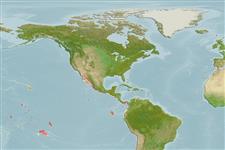Classification / Names
आम नाम | उपशब्द | Catalog of Fishes(वर्ग, प्रजाति) | ITIS | CoL | WoRMS | Cloffa
>
Blenniiformes (Blennies) >
Dactyloscopidae (Sand stargazers)
Etymology: Myxodagnus: Greek, myxos = mucus + Greek, agnos = pure (Ref. 45335); walkeri: Named after Boyd W. Walker in recognition of his fieldwork which produced much of the present material and many other eastern Pacific dactyloscopids (Ref. 39697).
Environment: milieu / climate zone / depth range / distribution range
पारिस्थितिकी
समुद्री ड़िमरसल; गहराई सीमा 0 - 6 m (Ref. 39697). Tropical
वितरण
देश | ऐफ ऐ ओ क्षेत्र | Ecosystems | संयोग | Point map | भूमिका | Faunafri
Eastern Central Pacific: Nayarit, Mexico and Golfo de Nicoya, Costa Rica.
आकार / वज़न / Age
Maturity: Lm ? range ? - ? cm
Max length : 5.5 cm SL पुल्लिंग / अलिंग; (Ref. 39697)
Short description
पहचान कुंजी | आकृति विज्ञान | मौरफोमैटरिक्स
पृष्ठीय रीढ़ (सम्पूर्ण) : 8 - 10; पृष्ठीय सौफट रेज़ (सम्पूर्ण) : 28 - 31; ऐनल सौफट रेज़: 33 - 38. Preorbital length longer than diameter of pigmented eye; upper lip fimbriae usually 10-11; modally 2 pores in 1st preopercular canal; dorsum of head mainly speckled with small brown spots, without large blotches or spots; without a distinct suborbital bar or prominent blotches on lower jaw (Ref. 39697).
Life cycle and mating behavior
Maturities | पुनरुत्पत्ति | Spawnings | Egg(s) | Fecundities | लार्वा
Dawson, C.E., 1976. Studies on eastern Pacific sand stargazers 3. Dactylagnus and Myxodagnus, with description of a new species and subspecies. Copeia 1976(1):13-43. (Ref. 39697)
IUCN Red List Status (Ref. 130435)
Threat to humans
Harmless
Human uses
साधन
Special reports
Download XML
इंटरनेट स्रोत
Estimates based on models
Phylogenetic diversity index (Ref.
82804): PD
50 = 0.5312 [Uniqueness, from 0.5 = low to 2.0 = high].
Bayesian length-weight: a=0.01000 (0.00244 - 0.04107), b=3.04 (2.81 - 3.27), in cm total length, based on all LWR estimates for this body shape (Ref.
93245).
Trophic level (Ref.
69278): 4.3 ±0.6 se; based on size and trophs of closest relatives
Fishing Vulnerability (Ref.
59153): Low vulnerability (10 of 100).
